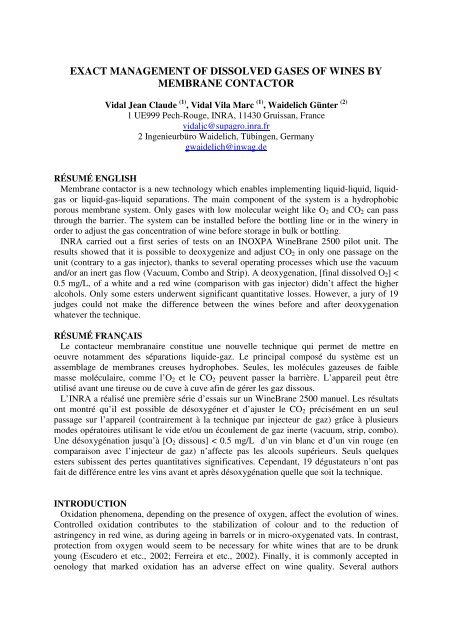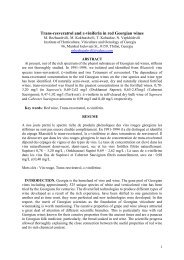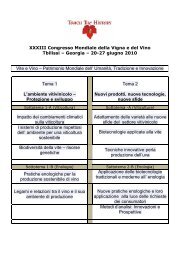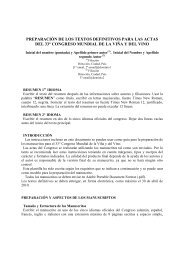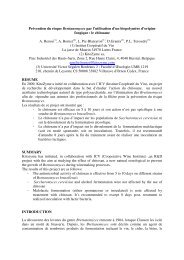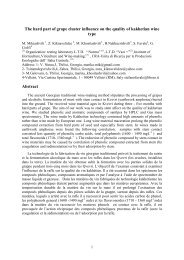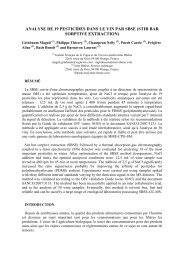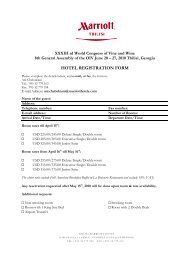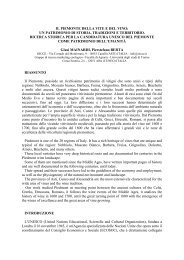exact management of dissolved gases of wines by ... - Oiv2010.ge
exact management of dissolved gases of wines by ... - Oiv2010.ge
exact management of dissolved gases of wines by ... - Oiv2010.ge
Create successful ePaper yourself
Turn your PDF publications into a flip-book with our unique Google optimized e-Paper software.
EXACT MANAGEMENT OF DISSOLVED GASES OF WINES BY<br />
MEMBRANE CONTACTOR<br />
Vidal Jean Claude (1) , Vidal Vila Marc (1) , Waidelich Günter (2)<br />
1 UE999 Pech-Rouge, INRA, 11430 Gruissan, France<br />
vidaljc@supagro.inra.fr<br />
2 Ingenieurbüro Waidelich, Tübingen, Germany<br />
gwaidelich@inwag.de<br />
RÉSUMÉ ENGLISH<br />
Membrane contactor is a new technology which enables implementing liquid-liquid, liquidgas<br />
or liquid-gas-liquid separations. The main component <strong>of</strong> the system is a hydrophobic<br />
porous membrane system. Only <strong>gases</strong> with low molecular weight like O 2 and CO 2 can pass<br />
through the barrier. The system can be installed before the bottling line or in the winery in<br />
order to adjust the gas concentration <strong>of</strong> wine before storage in bulk or bottling.<br />
INRA carried out a first series <strong>of</strong> tests on an INOXPA WineBrane 2500 pilot unit. The<br />
results showed that it is possible to deoxygenize and adjust CO 2 in only one passage on the<br />
unit (contrary to a gas injector), thanks to several operating processes which use the vacuum<br />
and/or an inert gas flow (Vacuum, Combo and Strip). A deoxygenation, [final <strong>dissolved</strong> O 2 ] <<br />
0.5 mg/L, <strong>of</strong> a white and a red wine (comparison with gas injector) didn’t affect the higher<br />
alcohols. Only some esters underwent significant quantitative losses. However, a jury <strong>of</strong> 19<br />
judges could not make the difference between the <strong>wines</strong> before and after deoxygenation<br />
whatever the technique.<br />
RÉSUMÉ FRANÇAIS<br />
Le contacteur membranaire constitue une nouvelle technique qui permet de mettre en<br />
oeuvre notamment des séparations liquide-gaz. Le principal composé du système est un<br />
assemblage de membranes creuses hydrophobes. Seules, les molécules gazeuses de faible<br />
masse moléculaire, comme l’O 2 et le CO 2 peuvent passer la barrière. L’appareil peut être<br />
utilisé avant une tireuse ou de cuve à cuve afin de gérer les gaz dissous.<br />
L’INRA a réalisé une première série d’essais sur un WineBrane 2500 manuel. Les résultats<br />
ont montré qu’il est possible de désoxygéner et d’ajuster le CO 2 précisément en un seul<br />
passage sur l’appareil (contrairement à la technique par injecteur de gaz) grâce à plusieurs<br />
modes opératoires utilisant le vide et/ou un écoulement de gaz inerte (vacuum, strip, combo).<br />
Une désoxygénation jusqu’à [O 2 dissous] < 0.5 mg/L d’un vin blanc et d’un vin rouge (en<br />
comparaison avec l’injecteur de gaz) n’affecte pas les alcools supérieurs. Seuls quelques<br />
esters subissent des pertes quantitatives significatives. Cependant, 19 dégustateurs n’ont pas<br />
fait de différence entre les vins avant et après désoxygénation quelle que soit la technique.<br />
INTRODUCTION<br />
Oxidation phenomena, depending on the presence <strong>of</strong> oxygen, affect the evolution <strong>of</strong> <strong>wines</strong>.<br />
Controlled oxidation contributes to the stabilization <strong>of</strong> colour and to the reduction <strong>of</strong><br />
astringency in red wine, as during ageing in barrels or in micro-oxygenated vats. In contrast,<br />
protection from oxygen would seem to be necessary for white <strong>wines</strong> that are to be drunk<br />
young (Escudero et etc., 2002; Ferreira et etc., 2002). Finally, it is commonly accepted in<br />
oenology that marked oxidation has an adverse effect on wine quality. Several authors
showed also that 2 mg/L <strong>of</strong> oxygen moreover on white <strong>wines</strong> involved significant sensory<br />
modifications after a few months (Berta et etc., 2000; Boulet, Vidal, 1999). Therefore, various<br />
studies undertaken to characterize the appearance <strong>of</strong> <strong>dissolved</strong> oxygen during operations<br />
performed on <strong>wines</strong> show that bottling is one <strong>of</strong> the most critical phases (Vidal et etc., 2004;<br />
Castellari et etc., 2004), especially as once the bottles have been sealed, the only remaining<br />
means for mastering the evolution <strong>of</strong> <strong>wines</strong> are the storage parameters (closure permeability,<br />
temperature, relative humidity, light, etc.).<br />
On one side, the presence <strong>of</strong> O 2 in the <strong>wines</strong>, following its dissolution, is not a stable state in<br />
time. Dissolved oxygen is gradually consumed <strong>by</strong> various substrates, mainly polyphenols<br />
(Singleton et etc., 1979). The disappearance <strong>of</strong> floral flavours is faster under the effect <strong>of</strong><br />
oxygen additions even at 15°C and at the organoleptic level, aromatic deteriorations arrive<br />
before chromatic deteriorations (Escudero et etc., 2002).<br />
On the other side, CO 2 is produced in a large quantity <strong>by</strong> yeasts (81 g/L for wine <strong>of</strong> 10%<br />
vol.) and lactic acid bacteria (1.6 g/L for 5 g/L <strong>of</strong> malic acid) during alcoholic and malolactic<br />
fermentations. During storage and various treatments <strong>of</strong> the wine, the carbon dioxide content<br />
tends to decrease because <strong>of</strong> the tendency to equilibrate the CO 2 partial pressure <strong>of</strong> the wine<br />
with the atmospheric partial pressure. Finally variable quantities remain at the time <strong>of</strong> the<br />
bottling. However the carbonic gas plays a key role in the organoleptic characters <strong>of</strong> the<br />
<strong>wines</strong>, even if its content is lower than its perception threshold (500 mg/L). Thus adjusting the<br />
carbon dioxide content <strong>of</strong> <strong>wines</strong> has a great importance from the sensorial point <strong>of</strong> view. The<br />
CO 2 content in bottled <strong>wines</strong> will have to be adjusted approximately to 300 mg/L for the red<br />
<strong>wines</strong> for ageing and up to 800-1800 mg/L for the white and rosé <strong>wines</strong>.<br />
Already used in waters, beverages and effluents treatments, membrane contactors present a<br />
great interest in oenology because this new technology enables implementing liquid-liquid,<br />
liquid-gas or liquid-gas-liquid separations. The main component <strong>of</strong> the system is a<br />
hydrophobic porous membrane system. Only <strong>gases</strong> with low molecular weight like O 2 and<br />
CO 2 can pass through this barrier. It is possible to reduce <strong>dissolved</strong> <strong>gases</strong> (eg CO 2 , O 2 ) or to<br />
add for example CO 2 in <strong>wines</strong> before conditioning in bottles or in bag-in box.<br />
After a presentation <strong>of</strong> this new technology and <strong>of</strong> the manual membrane contactor used,<br />
this study describes the first results obtained <strong>by</strong> INRA experimental unit <strong>of</strong> Pech-Rouge<br />
(France) for the <strong>management</strong> <strong>of</strong> <strong>dissolved</strong> <strong>gases</strong> <strong>of</strong> still <strong>wines</strong>. The main aim <strong>of</strong> these trials<br />
was to reduce the <strong>dissolved</strong> oxygen content to a level lower than 0.5 mg/L in order to increase<br />
the shelf life <strong>of</strong> the <strong>wines</strong>. At the same time, the <strong>dissolved</strong> carbon dioxide content is adjusted<br />
to a level between 300 and 1800 mg/L according to the type and the style <strong>of</strong> the wine for<br />
sensorial reasons.<br />
MATERIALS AND METHODS<br />
WineBrane ® membrane contactor:<br />
The WineBrane ® skit (INOXPA patent pending) consists <strong>of</strong> one or several membrane<br />
contactors in the way, that when connected with the operation and secondary medium,<br />
multiple treating processes are possible. The power spectrum <strong>of</strong> the plant covers flow rates<br />
between 1000 and 20000 litres <strong>of</strong> wine per hour for the gas <strong>management</strong> (Schmidt et etc.,<br />
2010).<br />
The design and construction <strong>of</strong> the units is performed in compliance with the requirements<br />
<strong>of</strong> the food-processing industry. The membrane material is polypropylene and it has FDA<br />
approval.<br />
The design is CIP cleanable (alkaline solution and disinfectants), units can also be sanitised<br />
with hot water.
Operating principle and technical specifications <strong>of</strong> the used unit:<br />
The Liqui-Cel (MEMBRANA) membrane contactor module consists <strong>of</strong> a woven assembly<br />
<strong>of</strong> polypropylene hollow membrane fibres <strong>of</strong> 200 µm interior diameter with an average size <strong>of</strong><br />
pores <strong>of</strong> 0.03 µm “Figure 1” which allows only the passage <strong>of</strong> <strong>gases</strong> or volatile compounds <strong>of</strong><br />
low molecular weight.<br />
The hydrophobic character <strong>of</strong> the membrane confers to the role <strong>of</strong> interface between the<br />
liquid phase which moves outside the hollow fibres (shell side) and the gas phase which<br />
moves in opposite direction inside the hollow fibres (lumen side), preventing the mixture <strong>of</strong><br />
the phases. The balance <strong>of</strong> concentrations is displaced when a depression and/or a gas flow is<br />
introduced. A diffusion force is created due to the differential pressure between gas phase and<br />
<strong>dissolved</strong> <strong>gases</strong> in the liquid phase, which migrates in the gas through the membrane (or<br />
conversely) until a new differential pressure balance is reached. This physical mechanism can<br />
be described in a basic way <strong>by</strong> the principle <strong>of</strong> osmosis. If there are volatile compounds with a<br />
higher concentration on a side <strong>of</strong> the membrane compared to the other, then these compounds<br />
will cross the membrane until the equilibrium <strong>of</strong> the partial pressures <strong>of</strong> these compounds on<br />
the two sides <strong>of</strong> the membrane is attained.<br />
Figure 1: Liqui-cel cartridge and microscopic photos <strong>of</strong> membranes.<br />
The membrane contactor used was a manual WineBrane ® 2500 (25 hL/h), provided with a<br />
Liqui-cel 4X13” ExtraFlow X40 cartridge <strong>of</strong> membrane surface area equal to 8.1 m². A<br />
monobloc lobe pump enables wine circulation in shell side <strong>of</strong> membrane, while the strip gas<br />
with or without vacuum (produced <strong>by</strong> a liquid ring vacuum pump), circulates in opposite<br />
direction on lumen side <strong>of</strong> the membrane “Figure 2”.<br />
Figure 2: Manual WineBrane ® 2500 used for experiments.
Operating modes <strong>of</strong> WineBrane 2500:<br />
VACUUM mode: the use <strong>of</strong> vacuum lower than 100 hPa in lumen side reduces O 2 and CO 2<br />
according to their partial gas pressure out <strong>of</strong> the wine. The gas molecules, which crossed the<br />
membrane wall, are then eliminated <strong>by</strong> the vacuum pump. Thus, vacuum deoxygenizes and<br />
decarbonises the wine at the same time.<br />
CARBONATION mode: to readjust CO 2 content, it is necessary to carry out a second<br />
passage without vacuum but <strong>by</strong> a CO 2 sweep with low overpressure in lumen side (∆ pressure<br />
between lumen side and shell side = 200-300 hPa). A back pressure is applied on the outlet <strong>of</strong><br />
the gas side, to force CO 2 to pass into the wine.<br />
In addition to the two previous modes, INRA carried out two new modes in order to check if<br />
it is possible to deoxygenize and adjust the CO 2 content in only one passage in the WineBrane<br />
skit.<br />
STRIP mode: an inert gas circulation (N 2 , CO 2 or N 2 /CO 2 mixture) in lumen side will make<br />
it possible to impoverish the oxygen content <strong>of</strong> wine <strong>by</strong> keeping the CO 2 concentration. If<br />
CO 2 partial pressure <strong>of</strong> carrier gas is higher than that <strong>of</strong> wine, the wine will enrich in CO 2 . In<br />
the opposite case, the wine will be impoverished in CO 2 . Roughly, if the carrier gas contains<br />
approximately more than 20% <strong>of</strong> CO 2 , a red wine will enrich in CO 2 (50% for the white and<br />
rosé <strong>wines</strong>).<br />
The strip mode is used to increase CO 2 concentration at the same time as to reduce O 2<br />
concentration. If a strong carrier gas flow is introduced, O 2 will be reduced but with a higher<br />
carrier gas consumption.<br />
COMBO mode: a partial vacuum is coupled to an inert gas flow in lumen side, in order to<br />
deoxygenise the wine and to adjust its CO 2 content.<br />
The combo mode is used when the aim is to keep CO 2 concentration at the same time as to<br />
reduce O 2 concentration. This mode is more efficient for deoxygenating at constant CO 2 level<br />
because the carrier gas consumption is lower than with strip mode at same deoxygenation<br />
level.<br />
Moreover, carrier gas consumption (CO 2 ) in the combo mode is more important than in strip<br />
mode to increase CO 2 content <strong>of</strong> the wine. And the strip mode is more efficient than combo<br />
mode when wine needs a strong carbonation (when initial CO 2 is much lower than target<br />
CO 2 ) at the same time as a deoxygenation.<br />
Methods <strong>of</strong> Analysis for gaseous molecules:<br />
Oxygen control at inlet and outlet side <strong>of</strong> the apparatus was carried out <strong>by</strong> PreSens<br />
luminescent probe and PSt3 luminescent spots glued onto inner surface <strong>of</strong> the sight glass<br />
“Figure 3”. A PreSens Fibox 3 trace fiber optic probe was used. The Fibox 3 measures the<br />
luminescence decay time <strong>of</strong> an immobilized luminophore. The luminophore is excited with a<br />
sinusoidal intensity-modulated monochromatic light delivered <strong>by</strong> an optical fibre and its<br />
decay time causes a time delay in the light signal emitted <strong>by</strong> the luminophore. This decay<br />
time, or phase angle, Φ, decreases in the presence <strong>of</strong> oxygen and is correlated to oxygen<br />
content.<br />
The PSt3 sensor selected to perform this study can be used for a broad range <strong>of</strong> oxygen<br />
concentration ranging from 0 to 50 %.
Figure 3: PreSens system with its optical fibre and its PSt3 spot glued in a sight glass.<br />
CO 2 control was carried out <strong>by</strong> Carbodoseur to the sample taps located at inlet and outlet<br />
side <strong>of</strong> the apparatus.<br />
GC analyses <strong>of</strong> higher alcohols and esters <strong>of</strong> wine (headspace sampler coupled to GC<br />
Agilent 6850) were performed on samples taken at inlet and outlet side <strong>of</strong> the apparatus.<br />
RESULTS AND DISCUSSION<br />
The <strong>wines</strong> used (75% <strong>of</strong> white or rosé, 25% <strong>of</strong> reds) were micro filtered before treatment.<br />
All treatments were carried out from tank to tank <strong>by</strong> the racking connection valves. The<br />
average temperature <strong>of</strong> the <strong>wines</strong> was <strong>of</strong> 23.9 ± 1.8°C, except for 4 batches (< 7°C).<br />
The combo and strip modes developed <strong>by</strong> INRA UEPR allowed in only one passage on<br />
WineBrane ® pilot to deoxygenize the <strong>wines</strong> as well as <strong>by</strong> the vacuum mode while controlling<br />
the CO 2 content “Tab. 1”. The CO 2 content <strong>of</strong> <strong>wines</strong> treated <strong>by</strong> the vacuum strongly<br />
decreases. The O 2 content after carbonation is almost stable.<br />
Table 1: Summary <strong>of</strong> treatments <strong>of</strong> <strong>wines</strong> carried out <strong>by</strong> INRA.<br />
Average ± standard deviation for the 4 last columns.<br />
*For choosing combo, strip or carbonation mode, the final CO 2 content depends on the required CO 2 quantity.<br />
The required CO 2 quantity is limited <strong>by</strong> the temperature and the strip gas CO 2 concentration, according to the<br />
abacus <strong>of</strong> Lonvaud-Fumel, 1976, and also the strip gas mass flow as well as the differential <strong>of</strong> pressure between<br />
Mode<br />
Nb <strong>of</strong><br />
batches<br />
Total<br />
volume hL<br />
lumen and shell side.<br />
Initial [O 2 ]<br />
mg/L<br />
Initial [CO 2 ]<br />
mg/L<br />
Deoxygenation<br />
output %<br />
Final [CO 2 ]<br />
mg/L<br />
Vacuum 10 107 4.25 ± 2.82 500 ± 643 - 88.1 ± 3.3 133 ± 140<br />
Carbonation 3 55 0.56 ± 0.09 315 ± 33 + 4.6 ± 3.2 1425 ± 459<br />
Strip 16 360 0.98 ± 0.32 509 ± 227 - 84.5 ± 4.3 645 ± 297<br />
Combo 19 256 2.28 ± 2.31 446 ± 266 - 87.8 ± 4.5 537 ± 359<br />
For carbonation, strip and combo modes, these first tests showed that consumption <strong>of</strong> carrier<br />
gas is close to 0.5 L CO 2 / L <strong>of</strong> wine for an addition <strong>of</strong> 300 mg/L <strong>of</strong> CO 2 from an initial CO 2<br />
content <strong>of</strong> 700 mg/L.<br />
Moreover, we observed a diminution <strong>of</strong> the flow on red <strong>wines</strong>, perhaps because polyphenols<br />
constitute a hydrophobic bio film near the membrane.<br />
Oenological and volatile compounds analyses:<br />
Whatever the used operating process, alcohol percentage, volatile acidity, pH values, free<br />
and total SO 2 data and absorbance values at 420, 520 and 620 nm were not modified.
GC analyses <strong>of</strong> higher alcohols and esters <strong>of</strong> wine showed that only some esters underwent<br />
significant losses being able to go up to 40%, especially ethyl-octanoate, ethyl-hexanoate,<br />
isoamyl-acetate and hexyl-acetate, which are the most hydrophobic molecules, which thus<br />
have most affinity for the membrane passage according to Diban et etc., 2008.<br />
Comparatively, deoxygenation <strong>of</strong> the <strong>wines</strong> <strong>by</strong> nitrogen sparging with porous diffuser<br />
causes important losses for the same molecules because <strong>of</strong> their volatility.<br />
Sensory analysis <strong>by</strong> triangular test<br />
A white and a red wine with respective O 2 initial contents <strong>of</strong> 0.79 and 0.82 mg/L and CO 2<br />
initial content <strong>of</strong> 620 and 260 mg/L were deoxygenized <strong>by</strong> sparger and with WineBrane ® <strong>by</strong><br />
strip and combo modes (T° <strong>wines</strong> = 23 ± 1°C). The final average O 2 contents were<br />
respectively <strong>of</strong> 0.20 (white) and 0.14 mg/L (red) and for CO 2 <strong>of</strong> 669 ± 68 (white) and 255 ±<br />
36 mg/L (red). 15 days after, a triangular test was carried out <strong>by</strong> 19 tasters in order to compare<br />
the wine before and after the deoxygenation for each wine and each treatment. No significant<br />
difference was revealed to the α risk <strong>of</strong> 5%, in spite <strong>of</strong> the ester losses quoted previously.<br />
Only the <strong>wines</strong> deoxygenized <strong>by</strong> sparger (porous diffuser) were considered to be different<br />
from the control <strong>wines</strong> to the α risk = 14.6% (white) and 6.5% (red).<br />
CONCLUSIONS<br />
The <strong>dissolved</strong> gas <strong>management</strong> <strong>by</strong> membrane contactor constitutes a real progress during<br />
the phase for conditioning <strong>of</strong> <strong>wines</strong>. A full automatic WineBrane ® unit integrated in a bottling<br />
line (like at the wine coop <strong>of</strong> Besigheim) or in a bag in box line enables the simultaneous<br />
control and adjustment <strong>of</strong> the two most important <strong>dissolved</strong> <strong>gases</strong> in oenology: the oxygen<br />
major factor <strong>of</strong> the <strong>wines</strong> oxidation and the carbonic gas major factor <strong>of</strong> the sensory quality <strong>of</strong><br />
<strong>wines</strong>. Currently no competitive technology is available which is able to meet these needs<br />
accurately and simultaneously in line.<br />
The first tests showed that the main analytical parameters (alcohol, acidities and colour) are<br />
not affected <strong>by</strong> the treatment. Only losses in some esters were observed without impact on the<br />
tasting <strong>of</strong> the wine.<br />
Further studies starting this year will focus on gaseous exchange and on the behaviour <strong>of</strong><br />
polyphenols. For that, other operating conditions like temperature variation, different gas<br />
concentrations, wine types, inert gas consumptions … will be verified.<br />
ACKNOWLEDGEMENT<br />
The authors thank Magaly Angénieux from INRA 999UE Pech-Rouge for the GC analysis<br />
<strong>of</strong> volatile compounds and the INOXPA Company for the provision <strong>of</strong> the WineBrane pilot<br />
unit.<br />
BIBLIOGRAPHY<br />
Berta P., Spertino M., Vallini E., 2000. Controllo dell’ossigeno durante l’imbottigliamento<br />
di vini frizzanti e spumanti. Industrie delle Bevande, 2000, XXIX dicembre, 618-622.<br />
Boulet J.C., Vidal J.C., 1999. Dissolution d’oxygène à la mise en bouteille. Compte rendu<br />
d’expérimentation INRA UE PR Gruissan.<br />
Castellari M., Simonato B., Torinielli G.B., Spinelli P., Ferrarini R, 2004. Effects <strong>of</strong><br />
different enological treatments on <strong>dissolved</strong> oxygen in <strong>wines</strong>. Ital. J. Food Sci., vol16,nº3,<br />
387-396.
Diban N., Athes V., Bes. M., Souchon I., 2008. Ethanol and aroma compounds transfer<br />
study for partial dealcoholisation <strong>of</strong> wine using membrane contactor. Journal <strong>of</strong> membrane<br />
science. 311, 136-146.<br />
Escudero A., Asensio E., Cacho J., Ferreira V., 2002. Sensory and chemical changes <strong>of</strong><br />
young white <strong>wines</strong> stored under oxygen. An assessment <strong>of</strong> the role played <strong>by</strong> aldehydes and<br />
some other important odorants. Food Chem., 77, 325-331.<br />
Ferreira A.C.S., Guesdes De Pinho P., Rodrigues P., Hogg T., 2002. Kinetics <strong>of</strong> oxidative<br />
degradation <strong>of</strong> white <strong>wines</strong> and how they are affected <strong>by</strong> selected technological parameters. J.<br />
Agric. Food Chem., 50, 5919-5924.<br />
Lonvaud-Fumel A., 1976. Recherches sur le Gaz Carbonique des Vins. Thèse présentée à<br />
l’Université de Bordeaux II le 4 mars 1976.<br />
Schmidt O., Vidal J.C., Waidelich G., 2010. New approach <strong>by</strong> membrane contactor to<br />
manage <strong>dissolved</strong> <strong>gases</strong> in wine and to reduce alcohol content <strong>of</strong> the wine. 60 th International<br />
IVIF congress. Stuttgart. Communication orale.<br />
Singleton V.L., Trousdale E., Zaya, J., 1979. Oxidation <strong>of</strong> <strong>wines</strong> I. Young white <strong>wines</strong><br />
periodically exposed to air. Am. J. Enol. Vitic. , 30, 49-54.<br />
Vidal J.C., Boulet J.C., Moutounet M., 2004. Les apports d’oxygène au cours des<br />
traitements des vins. Bilan des observations sur site. 3 ème partie. Rev. Fr Oenol., 205, 25-33.


